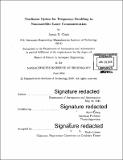| dc.contributor.advisor | Kerri Cahoy. | en_US |
| dc.contributor.author | Clark, James R., Ph. D. Massachusetts Institute of Technology | en_US |
| dc.contributor.other | Massachusetts Institute of Technology. Department of Aeronautics and Astronautics. | en_US |
| dc.date.accessioned | 2016-12-05T19:54:53Z | |
| dc.date.available | 2016-12-05T19:54:53Z | |
| dc.date.copyright | 2016 | en_US |
| dc.date.issued | 2016 | en_US |
| dc.identifier.uri | http://hdl.handle.net/1721.1/105611 | |
| dc.description | Thesis: S.M., Massachusetts Institute of Technology, Department of Aeronautics and Astronautics, 2016. | en_US |
| dc.description | Cataloged from PDF version of thesis. | en_US |
| dc.description | Includes bibliographical references (pages 109-112). | en_US |
| dc.description.abstract | In this work, we assess the utility of nonlinear optics for frequency-doubling to enable free space optical (FSO) communication links to take advantage of the ability to switch between two wavelengths using one transmit module. Our analysis shows that incorporating frequency-doubling with nonlinear optics into existing communication system designs can improve the link margin of FSO crosslinks by 3-4 dB, taking advantage of more favorable propagation and detector properties for the crosslink wavelength (775 nm) compared with the downlink wavelength (1550 nm). Using a frequency-doubler (65 g) allows the transmitter to use Commercial Off The Shelf (COTS) laser communication hardware at 1550 nm, without having to carry a second seed laser, modulator, and EDFA (200 g). This improvement is largely driven by the reduction in beamwidth that comes with the higher frequency, and is not substantially greater than the improvement that comes with using the same narrower beamwidth at 1550 nm, although SHG would allow a diffraction-limited system to use different beamwidths for beacon acquisition and communication without any moving parts. For links at extreme ranges, where linear-mode APDs are insufficient and photon-counting Geiger-mode APDs are required, frequency-doubling can provide up to 10 dB of channel capacity improvement. Additionally, frequency-doubling shows promise as a means to allow CubeSats and nano/microsatellites to use their communications lasers to also serve as satellite guidestars, and frequency-differencing may be employed to allow communication lasers to generate longer infrared wavelengths suitable for atmospheric spectroscopy. | en_US |
| dc.description.statementofresponsibility | by James R. Clark. | en_US |
| dc.format.extent | 112 pages | en_US |
| dc.language.iso | eng | en_US |
| dc.publisher | Massachusetts Institute of Technology | en_US |
| dc.rights | M.I.T. theses are protected by copyright. They may be viewed from this source for any purpose, but reproduction or distribution in any format is prohibited without written permission. See provided URL for inquiries about permission. | en_US |
| dc.rights.uri | http://dspace.mit.edu/handle/1721.1/7582 | en_US |
| dc.subject | Aeronautics and Astronautics. | en_US |
| dc.title | Nonlinear optics for frequency-doubling in nanosatellite laser communication | en_US |
| dc.type | Thesis | en_US |
| dc.description.degree | S.M. | en_US |
| dc.contributor.department | Massachusetts Institute of Technology. Department of Aeronautics and Astronautics | en_US |
| dc.identifier.oclc | 962486258 | en_US |
